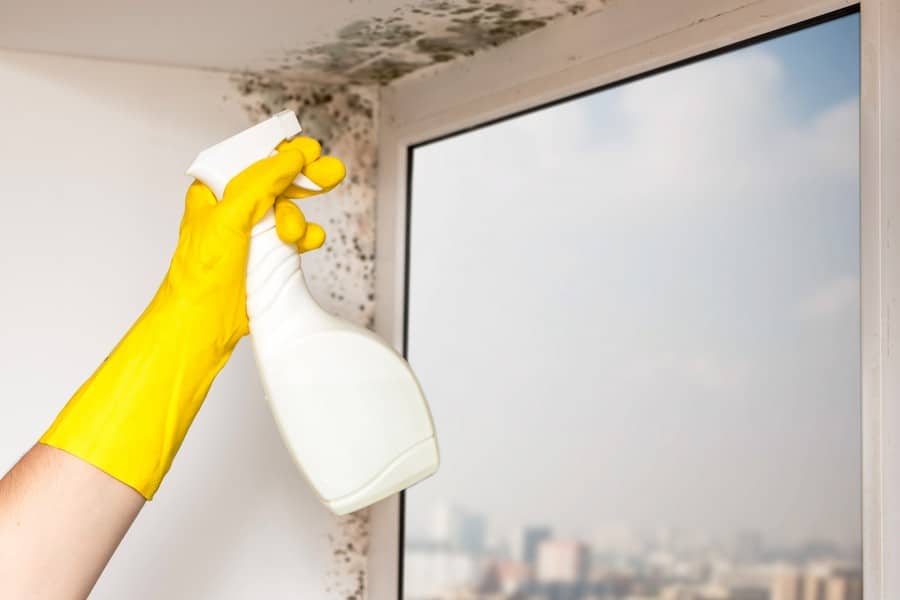Penetrating damp is the term used to describe moisture which enters a building from outside, through walls or roofs. This type of dampness can cause damage to the interior structure and decoration of a property – such as peeling paint, mould growth and rotting timbers. It’s essential that it be treated promptly in order to protect your home and its contents.
Lateral damp or penetrating damp, caused by water seeping from the outside into a building’s interior, is the most common type of damp in older buildings. It can occur at any level and in homes of any age – when brick or stone walls have deteriorated and become porous, creating a hole or leak that allows water to enter.
Penetrative damp, commonly referred to as rain penetration, is an issue caused by excessive water seeping into a residence through walls from the outside.
The Most Common Causes of Penetrating Damp
Faulty building work, leaky rainwater pipes and substandard ceilings of doors and windows can all lead to water penetration. When the outer material starts deteriorating, moisture can permeate walls, resulting in penetrating dampness.
A building flaw or external brick/stone wall decay due to age or neglect can lead to water permeating a home. Water may enter through walls, roofs, windows, and door surrounds at any level of the property; this is often caused by roof tile flaws, broken pointing, blocked weep holes, or faulty seals.
Frost and ageing, as well as damage caused by natural phenomena like storms and extreme weather, are the primary sources of penetrating damp in some structures.
Spotting Penetrating Damp
Look out for signs of penetrating damp such as mould growth, staining to walls, flooring or ceilings and/or damp patches in affected areas. Additionally, there may also be a musty smell present.
The air was pervaded by an oppressive, musty odour.
Interior wall damage (skirting boards) or exterior wall damage (roofing): these need to be inspected.
Patches of damp and black mould on the walls are patchy.
Stone masonry is often decorated with watermarks. These are created by pressing a wet cloth into the stone, which leaves an impression of whatever pattern was on the fabric. The marks offer an attractive design that enhances the appearance of stonework.
The dampness had already caused damage to the wood, creating the perfect environment for a wood rot fungus to take hold.
Areas Prone to Penetrating Damp
Common areas to inspect for penetrating dampness include walls, doors, windows, and roof joints. Check the external brickwork of your home for any signs of moisture or discoloration. Inspect around window frames and door frames too; these are prime spots where water can enter a building. Assess the condition of any eaves on your property as well – it’s an area often vulnerable to water seepage.
Inspecting common locations such as walls, doors, windows and roof joints can help identify penetration dampness. Examine exterior brickwork for any tell-tale signs of moisture or discoloration. Additionally look closely at window and door frames since these are prone to letting in water. Also assess the state of eaves which can be particularly vulnerable to water intrusion.
Investigating Penetration of Damp Through the Roof
Missing tiles, pointing, roof ridge tiles (the curved tiles at the apex of the roof), and flashing (where a roof meets a wall or chimney) must be checked for penetrating damp on a roof. Any absent or loose elements need maintenance to stop or contain moisture penetration.
Identifying and Mitigating Penetrating Damp Through Window Frames
Examine the window frame for gaps or cracks. If present, use a flexible sealant to fill them in. Verify that any existing gaps have been filled; if not, a hardwood strip 35mm from the front edge is an effective alternative. In addition, check beneath the window sill for a “drip groove” which prevents water from dripping onto the wall.
Detecting and Addressing Penetrating Damp in Door Frames
Any splits in the door frames should be fixed. Moreover, if your exterior door lacks a weather bar – a board that lies beneath the door and shields it from excessive rain – you may want to consider putting one in.
Identifying Penetration of Damp Through External Walls
Cracks in external brickwork or missing mortar can cause penetrating damp. To prevent this, ensure the holes are filled with a suitable filler material. Additionally, porous brickwork or cracks in render may also allow rainwater to seep through and should be addressed accordingly.
Preventing Penetrating Damp from Rain Gutters, Downpipes and External Drains
Examine the condition of exterior rainwater fixtures. If any are leaking, your house may be vulnerable to moisture infiltration. Inspect drains for blockages that can cause water backing up into the building.
It is possible that older, cracked or permeable chimney heads may have allowed water into your property. To remedy this, they must be repaired and painted with an exterior silicone water repellent or lime wash that enables the walls to breathe while still protecting them from moisture. Taking a preventative approach is advised; it’s better to identify any issue early on and save money than face a more costly repair down the line.
Treating Penetrating Damp: A Step-by-Step Guide
Establishing and identifying the cause of water infiltration is essential for effective treatment of penetrating damp. Usually, a problem with the building itself is the root cause; even in new construction, four common points of entry can affect a home:
Poorly executed pointing can be a major source of water penetration and potential damage to your property. It is essential that the mortar joints between bricks, blocks or stone are completely filled with fresh mortar and neatly finished off. If you notice any cracked, loose or missing pointing this should be repaired as soon as possible.
Faulty pointing can lead to water infiltration and pose a risk of damage to one’s home. It is imperative that mortar joints between bricks, blocks or stones are fully packed with new mortar and adequately finished. Any cracked, loose or absent pointing should be addressed promptly when noticed.
- The brickwork is full of pores.
- The brickwork has numerous pores.
- The walls in the house were cracked, with deep splits running through them.
- The walls of the house featured deep cracks, splitting them apart.
- could lead to a variety of problems.
- Faulty rainwater disposal systems can cause a range of issues.
- Maintaining each of these items in exceptional condition and promptly resolving any issues is paramount.
- To prevent the masonry from becoming waterlogged, it is imperative that any issues are addressed promptly.
Can Cavity Wall Insulation Lead to Penetrating Damp?
Cavity wall insulation is now very widespread as it increases the home’s ability to keep heat.
Most houses built in the UK after 1920 have cavity wall construction on their exterior walls. The inner and outer walls are separated by a gap, protecting the interior from moisture penetration. Rendering, painting or pebbledashing can be applied to the outside wall for aesthetic purposes.
In recent years, homeowners have found damp in their homes with hollow wall insulation. When moisture penetrates the exterior walls, it passes through the insulation and impacts interior walls of the property.
A lot of homeowners have had their cavity wall insulation fail, necessitating its removal.
Can Damp Affect Your Health?
If action is taken quickly to resolve the issue of penetrating damp, there should be no cause for health worries. As already mentioned, the key signs that indicate it is present are a musty smell and stains on walls; these may not look nice but do not pose any threat to wellbeing.
It is not ideal to live in damp conditions, and any problems should be addressed promptly. Severe penetrating damp can cause condensation issues, with black mould being an indication.
The Hazards of Penetrating Damp to Your Property
Even if it doesn’t penetrate walls, penetrating damp can cause harm to a property. Other issues include wet and dry rot, soggy plastering, more heat lost, musty smells, frost damage to brick work and unsightly water damage on the interior and exterior of a building.
Request a Penetration Damp Survey
Are you in doubt as to whether the mould you are seeing is due to condensation, a leak, lateral damp or rising damp? Would you like to know the severity of water damage and what actions should be taken for repair? We can assist with our damp survey and subsequent report.
At Brighton Damp Treatments, we assess the issue and use our expertise and moisture monitoring equipment to recommend a suitable treatment plan for your property in order to guarantee damp-proof walls.
How Long Does a Penetrating Damp Survey Last?
The size of the property, type of building, kind of damp problem and extent of damage all affect how long a dampness survey takes. For instance, a thorough investigation typically requires three to four hours. If you would like more information please contact us.
The Cost of a Penetrating Damp Survey
Moisture mapping is employed in our studies to ascertain the extent of your damp issue. We then investigate the probable causes and solutions, giving an account of them. The expense is contingent on a range of factors; each case must be carefully analysed before providing a reasonable estimate.
We have included an email report containing the survey data, conclusions and recommendations from our investigation into dampness.
If you have worries or questions concerning a property, please contact Brighton Damp Treatments customer service. We would be pleased to talk with you candidly and provide the information needed for you to continue.



